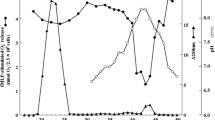Summary
Human neutrophils exposed to 10-4M doxorubicin and the derivatives epirubicin and thepirubicin revealed a different intracellular penetration and distribution pattern as demonstrated by fluorescence microscopy and fluorimetric determination of drug intracellular concentration. While doxorubicin was found to be a potent inducer of superoxide generation from resting cells, epirubicin exibited less superoxideinducing power. Thepirubicin on the contrary did not show any superoxide-inducing effect. Moreover the anthracyclines tested all inhibited the phorbol esterstimulated chemiluminescent response to the same extent, which suggested a common target for the drug action. Anthracycline-stimulated superoxide production seems to correlate with the cardiotoxic effects. The most cardiotoxic drug, doxorubicin, is the most potent inducer of superoxide generation, while epirubicin, which is less cardiotoxic, has a relatively limited effect on superoxide production. Thepirubicin which has been shown not to induce delayed cardiomyopathy has no effect on superoxide release from the cells.
Similar content being viewed by others
References
Babior BM (1984) The respiratory burst of phagocytes. J Clin Invest 73:599–601
Cheung K, Archibald AC, Robinson KF (1983) The origin of chemiluminescence produced by neutrophils stimulated by opsonized zymosan. J Immunol 130:2324–2329
Cohen HJ, Chovaniec ME (1978) Superoxide generation by digitonin-stimulated guinea pig granulocytes. J Clin Invest 61:1081–1087
Crawford DR, Schneider DL (1981) Evidence that a quinone may be required for the production of superoxide and hydrogen peroxide in neutrophils. Biochem Biophys Res Commun 99:1277–1286
Doroshow JH (1983) Effect of anthracycline antibiotics on oxygen radical formation in rat heart. Cancer Res 43:460–471
Ferrante A, Thong YH (1978) A rapid one-step procedure for purification of mononuclear and polymorphonuclear leukocytes from human blood using a modification of the hypaque-Ficoll technique. J Immunol Methods 24:389–393
Gianni L, Corden BJ, Myers CE (1983) The biochemical basis of anthracycline toxicity and antitumor activity. In: Hodgson E, Bend JR, Philpot RM (eds) Reviews in biochemical toxicology C. Elsevier, Amsterdam, pp 1–82
Helfman DM, Appelbaum D, Vogler WR, Kuo JF (1983) Phospholipid-sensitive Ca2+-dependent protein kinase and its substrates in human neutrophils. Biochem Biophys Res Commun 111:847–853
Kappus H (1986) Overview of enzyme systems involved in bioreduction of drugs and in redox cycling. Biochem Pharmacol 35:1–6
Katoh N, Wise BC, Wrenn RW, Kuo JF (1981) Inhibition by adriamycin-sensitive and phospholipid-sensitive calcium-dependent phosphorylation of the endogenous proteins from heart. Biochem J 198:199–205
Lown JW, Chen HH, Plambeck JA, Acton EM (1982) Further studies on the generation of reactive oxygen species from activate anthracyclines and the relationship to cytotoxic action and cardiotoxic effects. Biochem Pharmacol 31:575–581
Minnaugh EG, Trush MA, Ginsburg E, Gram TE (1982) Differential effects of anthracycline drugs on rat heart and liver microsomal reduced Nicotinamide Adenine Dinucleotide phosphate-dependent lipid peroxidation. Cancer Res 42:3574–3582
Mollinedo F, Schneider DL (1984) Subcellular localization of cytochrome b and ubiquinone in a tertiary granule of resting human neutrophils and evidence for a proton pump ATPase. J Biol Chem 259:7143–7150
Nishizuka Y (1984) The role of protein kinase C in cell surface signal transduction and tumour promotion. Nature 308:693–698
Pollakis G, Goormaghtigh E, Delmelle M, Lion Y, Ruysschaert JM (1984) Adriamycin and derivatives interaction with the mitochondrial membrane: O2 consumption and free radicals formation. Res Commun Chem Pathol Pharmacol 44:445–459
Seitz WR (1978) Chemiluminescence detection of enzymically generated peroxide. In: De Luca MA (ed) Methods in enzymology LVII. Academic Press, New York San Francisco London, pp 445–462
Tritton TR, Yee G (1982) The anticancer agent adriamycin can be actively cytotoxic without and entering cells. Science 217:248–250
Wise BC, Juo JF (1983) Modes of inhibition by acylcarnitine, adriamycin and trifluoperazine of cardiac phospholipid-sensitive calcium-dependent protein kinase. Biochem Pharmacol 32:1259–1265
Author information
Authors and Affiliations
Rights and permissions
About this article
Cite this article
Schinetti, M.L., Rossini, D. & Bertelli, A. Interaction of anthracycline antibiotics with human neutrophils: superoxide production, free radical formation and intracellular penetration. J Cancer Res Clin Oncol 113, 15–19 (1987). https://doi.org/10.1007/BF00389961
Received:
Accepted:
Issue Date:
DOI: https://doi.org/10.1007/BF00389961




